Related Research Articles
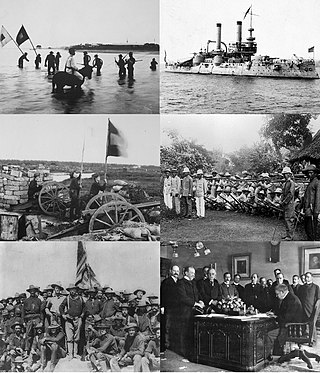
The Spanish–American War was a period of armed conflict between Spain and the United States. Hostilities began in the aftermath of the internal explosion of USS Maine in Havana Harbor in Cuba, leading to United States intervention in the Cuban War of Independence. The war led to the United States emerging predominant in the Caribbean region, and resulted in U.S. acquisition of Spain's Pacific possessions. It led to United States involvement in the Philippine Revolution and later to the Philippine–American War.
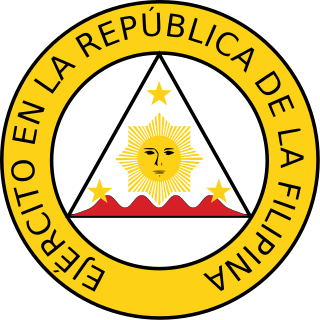
The Philippine Revolutionary Army, later renamed Philippine Republican Army, was the official armed forces of the First Philippine Republic from its formation in March of 1897 to its dissolution in November of 1899 in favor of guerilla operations in the Philippine–American War.
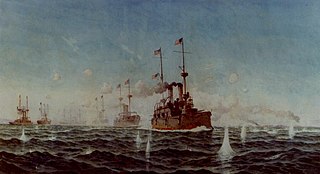
The Battle of Manila Bay, also known as the Battle of Cavite, took place on 1 May 1898, during the Spanish–American War. The American Asiatic Squadron under Commodore George Dewey engaged and destroyed the Spanish Pacific Squadron under Contraalmirante Patricio Montojo. The battle took place in Manila Bay in the Philippines, and was the first major engagement of the Spanish–American War. The battle was one of the most decisive naval battles in history and marked the end of the Spanish colonial period in Philippine history.

The Battle of Santiago de Cuba was a decisive naval engagement that occurred on July 3, 1898 between an American fleet, led by William T. Sampson and Winfield Scott Schley, against a Spanish fleet led by Pascual Cervera y Topete, which occurred during the Spanish–American War. The significantly more powerful US Navy squadron, consisting of four battleships and two armored cruisers, decisively defeated an outgunned squadron of the Royal Spanish Navy, which consisted of four armored cruisers and two destroyers. All of the Spanish ships were sunk and no American ship was lost. The crushing loss sealed American victory in the Cuban theater of the war ensuring the independence of Cuba from Spanish rule.

Admiral Pascual Cervera y Topete was a prominent Spanish naval officer with the rank of Almirante (admiral) who served in a number of high positions within the Spanish Navy and had fought in several wars during the 19th century. Having served in Morocco, the Philippines, and Cuba, he went on to be Spain's naval minister, chief of naval staff, naval attaché in London, the captain of several warships, and most notably, commander of the Cuba Squadron during the Spanish–American War. Although he believed that the Spanish Navy was suffering from multiple problems and that there was no chance for victory over the United States Navy, Cervera took command of the squadron and fought in a last stand during the Battle of Santiago de Cuba.

The Spithead and Nore mutinies were two major mutinies by sailors of the Royal Navy in 1797. They were the first in an increasing series of outbreaks of maritime radicalism in the Atlantic World. Despite their temporal proximity, the mutinies differed in character. The Spithead mutiny was a simple, peaceful, successful strike action to address economic grievances, while the Nore mutiny was a more radical action, articulating political ideals as well, which failed.
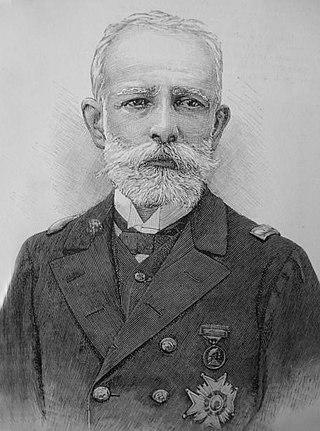
Rear Admiral Patricio Montojo y Pasarón was a career Spanish naval officer who commanded Spain's Pacific Squadron based in the Philippines during the Spanish–American War. Considered a man of high ability and experience, he was given the difficult task of defending the Spanish Philippines with a small navy and low supplies against a larger U.S. Asiatic Squadron. Despite his valor and determination, Montojo's navy was defeated at the Battle of Manila Bay by U.S. Navy Commodore George Dewey, which was a decisive naval battle of the war. He was later held accountable for the defeat and was court-martialed in Spain. Although the decision was later overturned, Montojo was still discharged from the Spanish Navy.

The Battle of Manila, sometimes called the Mock Battle of Manila, was a land engagement which took place in Manila on August 13, 1898, at the end of the Spanish–American War, four months after the decisive victory by Commodore Dewey's Asiatic Squadron at the Battle of Manila Bay. The belligerents were Spanish forces led by Governor-General of the Philippines Fermín Jáudenes, and American forces led by United States Army Major General Wesley Merritt and United States Navy Commodore George Dewey. American forces were supported by units of the Philippine Revolutionary Army, led by Emilio Aguinaldo.

The Philippine Navy (PN) is the naval warfare service branch of the Armed Forces of the Philippines. It has an estimated strength of 24,500 active service personnel, including the 8,300-strong Philippine Marine Corps. It operates 82 combat vessels, 14 auxiliary vessels, 25 manned aircraft and 8 unmanned aerial vehicles. It shares the responsibility of patrolling the maritime borders with the Philippine Coast Guard, a formerly attached unit which became a separate maritime law enforcement agency in 1998.
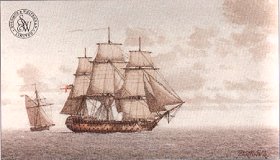
HMS Edgar was a 74-gun third-rate ship of the line of the Royal Navy, that saw service in the American Revolutionary, French Revolutionary and Napoleonic Wars. Launched in 1779, she fought in the battles of Cape St Vincent and Copenhagen, two of the major naval engagements of the wars.

The Greek frigate Hellas was the flagship of the Revolutionary Hellenic Navy. After an arbitration hearing in New York due to financial default by the Greek government, she was delivered to Greece in 1826. She was burned in 1831 by the Greek Admiral Andreas Miaoulis when the government of Ioannis Kapodistrias ordered her turned over to the Russian navy.

Reina Cristina was an Alfonso XII-class unprotected cruiser of the Spanish Navy built at the naval shipyard at Ferrol and launched 2 May 1887. Reina Cristina spent her early years in Spanish waters. In 1894 she was transferred to the Spanish Navy's Asiatic Squadron to deter any aggressive moves the German Empire might take against the Spanish-owned Caroline Islands in the Pacific. When Spain faced the "Tagalog Revolt" (1896–1897) – the Spanish name for the first two years of the Philippine Revolution – in the Philippine Islands, Reina Cristina was actively involved in the Spanish campaign to put down the revolt. In addition to patrolling Philippine waters to prevent the smuggling of contraband to the insurgents, she also supported Spanish Army actions against them at Cavite, Novaleta, and Binacayan, including the provision of naval gunfire support to Spanish troops ashore.

Admiral Manuel de la Cámara y Livermoore was a Spanish naval officer. He saw service in many of Spain′s wars of the second half of the nineteenth century and is most notable for commanding a relief squadron that made an abortive attempt to relieve Spanish forces in the Philippine Islands during the Spanish–American War.

USS Isla de Cuba was a former Spanish Navy second-class protected cruiser of the same name, captured by and commissioned into the United States Navy as a gunboat.

The Battles of La Naval de Manila were a series of five naval battles fought in the waters of the Spanish East Indies in the year 1646, in which the forces of the Spanish Empire repelled various attempts by forces of the Dutch Republic to invade Manila, during the Eighty Years' War. The Spanish forces, which included many native volunteers, consisted of two, and later, three Manila galleons, a galley and four brigantines. They neutralized a Dutch fleet of nineteen warships, divided into three separate squadrons. Heavy damage was inflicted upon the Dutch squadrons by the Spanish forces, forcing the Dutch to abandon their invasion of the Philippines.

The history of the Philippines from 1565 to 1898, Spanish Philippines, or Spanish Era, during which the Philippine Islands were ruled as the Captaincy General of the Philippines within the Spanish East Indies, initially under the Kingdom of the Viceroyalty of New Spain, based in Mexico City, until the independence of Mexico from Spain in 1821. This resulted in direct Spanish control during a period of governmental instability there. The Philippines was under direct royal governance from 1821 to 1898.

The Battle of Antón Lizardo was a naval engagement of the Mexican civil war between liberals and conservative governments,, which took place off the Gulf Coast town of Antón Lizardo, Mexico in 1860. A Mexican Navy officer, Rear Admiral Tomás M. Marín, mutinied and escaped to Havana, Cuba. There he formed a squadron of armed vessels to attack merchant ships and blockade Veracruz. The liberal Mexican Government of Benito Juárez declared Marín a pirate and permitted foreign navies to attack his ships. Juárez's government was supported by the United States and its navy already had several vessels patrolling in the Gulf of Mexico.

Rear Admiral Charles Jackson Train was an officer in the United States Navy. He served in the Spanish–American War and later as the second Commander-in-Chief of the United States Asiatic Fleet.

Cuba and the Philippines were both former Spanish colonies. Spanish rule on both countries was ended by the victory of the United States in the Spanish–American War as provisions of the Treaty of Paris giving Cuba independence and the Philippines becoming a new possession of the United States.
Compañía de Filipinas was a cargo steamship that was built in Scotland in 1890 for the Compañía General de Tabacos de Filipinas (CGTF). In the Philippine–American War the Navy of the First Philippine Republic armed her as its flagship and renamed her Filipinas. After that war she reverted to her original name and commercial service. In the Second World War, Japanese forces captured her and renamed her Hoei Maru. She was sunk in July 1945, shortly before the end of the war.
References
- ↑ FLAGSHIPS OF THE PHILIPPINE NAVY UP TO THE PRESENT DAY PUBLISHED: "MARITIME REVIEW" A Publication of The Maritime League. Page 5.
- ↑ History of the Philippine Navy
- ↑ Comprehensive History of the Philippine Navy by Joselito Zulueta